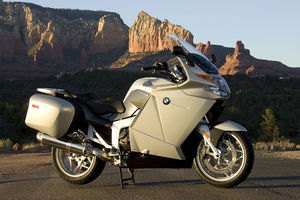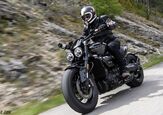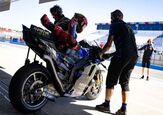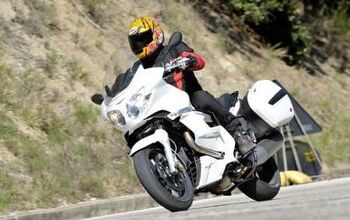2006 BMW K 1200 GT - Motorcycle.com
If you're a rider in the market for a new bike, model year 2006 has offered up a number of the "new and/or improved." For example, Triumph successfully re-introduced themselves into the supersport segment with the much adored Daytona 675. Kawasaki has seen fit to up the ante and at the same time upset the balance in the very narrow category of hyper-bike-cum-everyday-ride, long ruled by Suzuki's Hayabusa. And Yamaha has embarked on a quest to redefine how sport touring motorcycles may operate in the future; the FJR has been liberated of its clutch lever with the Yamaha Chip Controlled-Shift (YCC-S) as on option for '06. These are just a few of the benefits of being a motorcyclist today.
Not one to be left too far behind, BMW has also joined the fray this year with the introduction of their "all-new" K1200GT. Aimed squarely at its nearest two competitors, the FJR1300 from Yamaha and Honda's ST1300, BMW has made a concerted effort to raise the bar in what is quickly becoming a large segment of motorcycling: sport touring. How do they plan to shake things up?
By massaging a 152 horsepower at 9,500 rpm and 96 lbs./ft. torque at 7,750 rpm at the crank from 1,157 cubic centimeters of engine with a bore and stroke of 79mm x 59mm and a compression ratio of 13 to 1. The power plant is mounted transversally at 55 degrees in a composite aluminum frame. A six speed transmission helps translate the power from the four-valve, inline four. To reel in all that new found horsepower, the K 1200 GT has integral ABS (partial system) that uses two four-piston calipers to mercilessly clamp down on 320 mm dual, floating rotors up front and a single two-piston caliper to bind the 294 mm rotor for the rear.
Also standard is a set of trouble free and voluminous saddle bags matched to the bike's paint and, of all things, a brake pad replacement warning displayed on the "Info-Flat-Screen" that's conveniently placed between the analog speedo and tach. Suspension is handled by the now familiar and much esteemed Duolever up front and the EVO Paralever for the rear.The whole package weighs 549 lbs. dry or 622 lbs. wet. (The weights and horsepower/torque figures are of course, claimed figures from BMW.)
More standard items include the electronically-adjustable windshield that was designed to complement aerodynamic bodywork, an adjustable seat (from 32.3" to 33") and most interesting of all the standard features is the adjustable handlebar height. With a grand total of 1.6 inches of travel upward from its lowest position, the bars require nothing more than a simple Allen wrench to loosen two bolts. One journalist in attendance lowered the bars from their highest to lowest setting in a matter of minutes and reported it to have made a dramatic difference for his riding style. The newest K bike comes in three colors for '06: Dark Graphite Metallic, Crystal Gray Metallic and Deep Blue Metallic.
BMW automobiles are replete with options; the K 1200 GT motorbike is no different. Some familiar goodies, such as heated seats, heated hand grips, cruise control and BMW's ESA (push button electronic suspension adjustment) are just a few of the available options. They have also created two equipment packages; the top tier option package includes ESA,(covered in last year's K1200S intro) as well as an on board computer.
To help create a memorable riding impression, a variety of U.S. motor-journalists were summoned to Sedona, Arizona. Certainly BMW Motorrad USA didn't expect us to concentrate on the nuances of their latest sport-touring weapon while surrounded by some of the most incredible desert landscapes in the world, did they? Nevertheless, virtually all in attendance were left with impressions of the bike, rivaled only by those left by the stunning scenery. After over 200 miles of flat freeway droning, sharing city streets with cages (at a painfully slow pace) and a short but twisted mountain road, one question kept coming to mind, "Can a sport touring motorcycle get any better?" I had decided relatively early on in the test ride that this would be one of the easiest bikes I may ever review, due largely to the fact the GT left little to complain about.
"A brake set that is very powerful with more than enough feel to allow one-finger modulation."
The particular bike that I rode was, naturally, outfitted with most of the options offered, save for a taller windscreen and the anti-theft alarm. The bike starts easily and gets up to operating temperature quickly. The fuel injection works flawlessly from the slightest twist of the throttle all the way up to redline, which is around 10,200 rpm. Despite the claim of class-leading 152 horsepower at the crank, the GT never develops any top-end smack of acceleration. What it does exhibit (and I suspect dyno testing will prove) is a very linear but nonetheless powerful motor. A very minimal amount of engine vibration works its way through the foot pegs around the 4,000 rpm range but then quickly dissipates somewhere just north of the 5,000 rpm mark. Of equal note is just how quiet the whole operation is. No loud intake snort or cammy clatter worked its way into my memory.
Although no blistering paces were set during most of the day, I could still appreciate the force and sensitivity offered by the partial integral ABS; like other Beemers with this system, little servo motors work to assist in boosting braking power. The end result is a brake set that is very powerful with more than enough feel to allow one-finger modulation, even at speeds well beyond legal. The transmission is virtually transparent, just as exceptional as the rest of the engine, although a slight thud occurs when shifting into first from neutral. Not only is the tranny super slick, it shifted even more effortlessly while doing clutchless up shifts. Once again, there's little to say because it simply works so well.
"One of the handiest features a sport touring motorcycle in today's age can have is an electronically adjustable windscreen."
The smartly designed unit on the GT works exceptionally well. Due to the high daytime temperatures, I would often lower the screen all the way to allow myself to cool off, but eventually I raised it to its highest setting once under way to get the most wind protection.
Buffeting was never troublesome at any speed--or any position for that matter--and I never felt that annoying pressure on my back forcing me into the handlebars that many bikes with taller screens can generate. It does an excellent job of deflecting wind blast without impairing vision. If you're so inclined to tuck in, what you'll experience is an ultra-quiet, windless, little void.
Two things stand out about BMW motorcycles: refinement of the bike as a whole and superb handling. The K 1200 GT continues in this vein. With a steering angle of 61 degrees, 4.5 inches of trail and a wheelbase of 61.8 inches you might expect something more touring than sport. Yet, with the low center of gravity, thanks to the 55 degree angle position that the engine sits in the frame, the GT changes direction with ease and the chassis never protests in the slightest, even while trail braking or during mid-corner line changes. The motorcycle carries its claimed 622 lbs. of wet weight deceptively well, making the rider think the bike is lighter than it is. The low center of gravity and Paralever/Duolever combine to provide an unbelievably stable and well-mannered corner carver that changes direction with aplomb. It responded eagerly to steering inputs, both from the bars and subtle body English. Once the bike is set for a corner, it continues on its trajectory as if it were a laser-guided bullet train. A key factor that furthers this sensation is the surprising amount of ground clearance.
While tailing behind other riders during the day, I observed what I thought were modest lean angles that wouldn't lend to a truly sporting ride. Imagine my surprise once our ride took us up the mountain. Not only does the ground clearance coincide with stellar cornering abilities which inspire rider confidence, it began to make me think that perhaps there were no foot pegs at all.
The ESA system may be optional on the GT but you shouldn't give yourself any option other than to have it, should you purchase BMW's latest. I can't say unequivocally that it will make you corner like a demon while on the Sport setting but it most definitely will smooth out the road ahead when set to "Comfort." This feature will be appreciated the most while covering decaying roadways, where the surface is uneven from repairs, damage and generally rough pavement. Switching from either Sport or Normal to Comfort (all of which can be chosen on the fly), I noticed a marked difference in how the road surface was translated--or not--through the bike to me. It was quite amazing to suddenly have a somewhat bumpy ride turn into what felt like a perfect roadway, as if someone had swapped the road out from underneath me. With a total of nine different settings when multiplying the three riding style choices by the three load settings (solo, solo with luggage and passenger with luggage), ESA becomes less of an option and more of a requirement.
More by Pete Brissette, Managing Editor
































Comments
Join the conversation